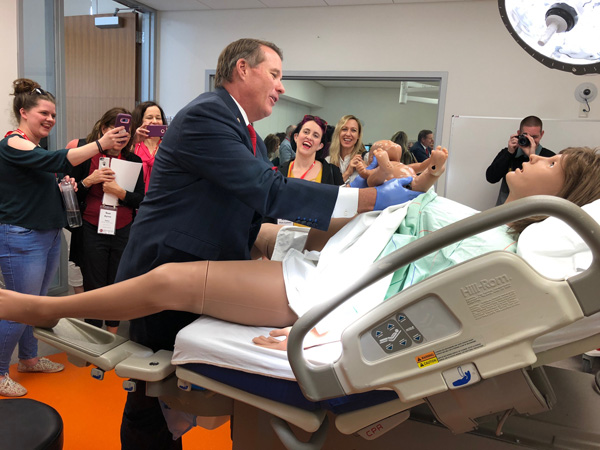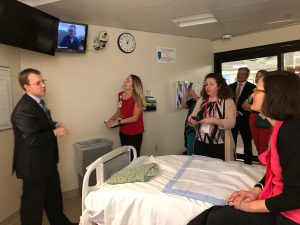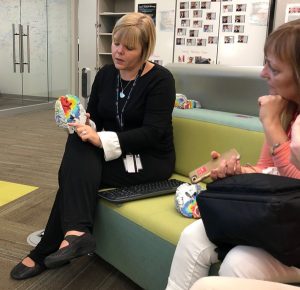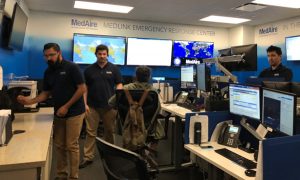
PHOENIX – Seventeen members of the Association of Health Care Journalists watched a simulated birth and viewed a giant brain mass through 3D glasses as part of a whirlwind tour of three Phoenix-area health care institutions on Thursday.
The tour was one of two field trips offered by AHCJ at its annual conference. Journalists visited the cancer center at Mayo Clinic-Phoenix, Banner-University Medical Center Phoenix, and the University of Arizona College of Medicine-Phoenix.
During the jam-packed day, Mayo Clinic officials showed off photon beam therapy and provided a tour of its cancer center, including its Precision Neurotherapeutics lab.

Banner-University Medical Center Phoenix highlighted their telemonitoring intensive care units, their new emergency room floor and a view of an air and sea emergency communications center headquartered at the hospital. The University of Arizona College of Medicine-Phoenix provided a tour of its Center for Simulation and Innovation and Center for Applied NanoBioscience and Innovation research lab.
“One of the field trip highlights for me was the visit to the Mayo Clinic’s precision neurotherapeutics lab,” said Betsy Taylor, AHCJ member and associate editor of Catholic Health World. “I love seeing cutting-edge work in person, rather than interviewing people on the phone. I learned just enough to know I want to learn more about the innovative data analysis and modeling they’re doing related to individual patients and cancer progression. I’ll be interested to follow how the lab’s work leads to more targeted treatments for specific patients.”

At Mayo’s Precision Neurotherapeutics lab, computer scientists are working with neurologists to build individualized treatment options for patients with brain tumors. Mayo created a communal working space, reminiscent of a Silicon Valley office, with couches and standing desks, where computer scientists and doctors can work comfortably with one another. Kristin Swanson, senior associate consultant for neurologic surgery at Mayo, explained that her team builds mathematical models to help physicians forecast the growth of brain tumors, which aids in more precise surgical, chemotherapy and radiation treatments.
The working space also contains a virtual reality lab where Matthew Welz, a neurological surgery research fellow at Mayo, takes MRIs of patients brain masses and builds a three-dimensional model that can be viewed through special glasses. The glasses allow brain surgeons to view a brain mass from multiple directions, aiding in surgery preparation.

AHCJ members then headed to Banner-University Medical Center Phoenix. A highlight of the visit included listening in on emergency calls coming into MedAire’s emergency response center. MedAire, a Phoenix-based company, receives about 500 calls a day from commercial airlines, private planes, and yachts, facing medical emergencies. The service employs nurses and doctors to be on call 24 hours a day. The call center is located on the same floor as Banner’s ER department, enabling the company to draw upon ER doctors if needed.
During the visit, MedAire received a call from a client, Etihad Airlines, flying from Manila to Abu Dhabi. A flight attendant reported that a 12-year-old female passenger had vomited six times. A physician on call at MedAire told the flight attendant to give her an anti-nausea medication that the airline carried on board and to call back if there were any more problems.
“Most of the calls we get are, someone vomited, someone fainted, or there is a kid with a fever,” said Carl, a MediAire communications specialist. Carl declined to provide his last name.

The field trip ended at the University of Arizona College of Medicine-Phoenix. A highlight included a visit to its Center for Simulation and Innovation and Center, where medical students get to practice on robotic dummies before treating real humans. Michael Foley, M.D., chair of the college’s Department of Obstetrics and Gynecology, demonstrated a “delivery” with a robotic model of a pregnant woman, for AHCJ members.
The “birth” was among the most entertaining portions of the field trip.











